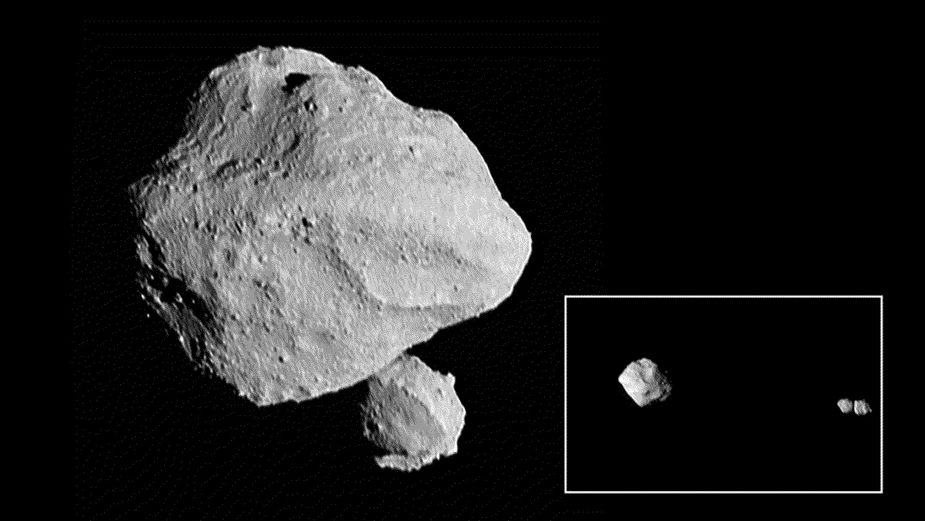“Lucy” discovers a double moon around asteroid Dinkinesh
DLR scientists made a surprising observation when analysing the image data from the NASA space probe
First a small surprise and then a big one: when NASA's Lucy space probe transmitted the first images to Earth after its flyby of the small asteroid Dinkinesh on 1 November 2023, it revealed a moon behind the 720-metre asteroid. The science team had previously considered the possibility that Dinkinesh might have a companion, as the light curves recorded using ground-based telescopes showed an irregularity that pointed to this. Now, however, the satellite was real. Then came more photos, and when the team examined them they were astonished: the Dinkinesh moon is made up of two parts, a so-called contact binary. The two touching satellites have diameters of 210 and 230 metres and orbit Dinkinesh at a distance of 3.1 kilometres in almost 53 hours. The German Aerospace Center (Deutsches Zentrum für Luft- und Raumfahrt; DLR) is involved in the discovery.
"The Lucy science team has been collecting data on Dinkinesh using telescopes since January 2023. At that point, Dinkinesh was added to our list of targets," said Simone Marchi, Deputy Project Investigator for the NASA Lucy mission; at the Southwest Reasearch Institute in Boulder, Colorado (USA). "We thought we had a pretty good idea of what Dinkinesh would look like thanks to the telescope data. But we were then thrilled to have made so many unexpected discoveries!" Dinkinesh's companion has now been named (152830) Dinkinesh I Selam by the International Astronomical Union (IAU), at the suggestion of the Lucy team.
"This is the first time that such a configuration has been observed," says a delighted Stefano Mottola from the DLR Institute of Planetary Research, a member of the Lucy science team. Together with Frank Preusker, also from the DLR Institute of Planetary Research, he is responsible for the photogrammetric analysis of the image data and the calculation of digital terrain models to determine the shape of the three observed bodies.
In preparation for the flyby, Mottola intensively analysed the light curves of the asteroid, which rotates around its axis and reflects the sunlight to varying degrees. "The shape of these light curves was unusual for a normally rotating body," Mottola continues. "A companion of Dinkinesh was therefore conceivable. But the fact that it would turn out to be a double body, a 'contact binary', came as a total surprise." The results of the Lucy flyby have been published in the scientific journal Nature.
Lucy is a mission in NASA's Discovery programme, which was launched on 16 October 2021. Its main targets are asteroids in Jupiter's orbit, known as Trojans, which precede or follow the planet by 60 degrees at two libration or Lagrange points. Several of these will initially be studied in 2027 and 2028, and will be observed again from 2033 onwards. The mission is named after a three-million-year-old fossilised skeleton that was unearthed in Ethiopia in 1974.
Publication:
Harold F. Levison et al.: A Contact Binary Satellite of the Asteroid (152830) Dinkinesh
Nature (2023). DOI: 10.1038/s41586-024-07378-0
Contact:
German Aerospace Center (DLR)
Rutherfordstraße 2, 12489 Berlin-Adlershof
Anja Philipp
Corporate Communications
Tel: +49 30 67055 8034
Dr. Stefano Mottola
Institute of Planetary Research
Planetary Geodesy
Ulrich Köhler
Institute of Planetary Research
www.dlr.de/pf
Press release DLR, 29 May 2024
